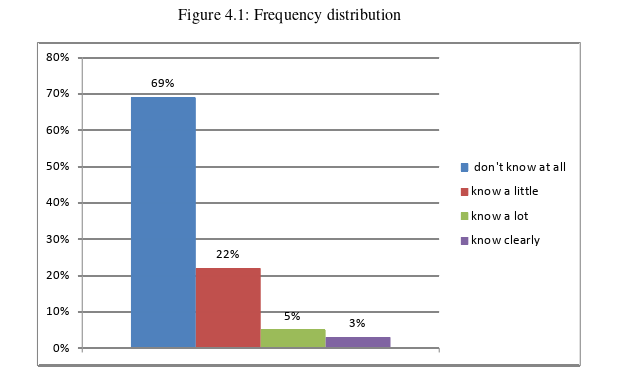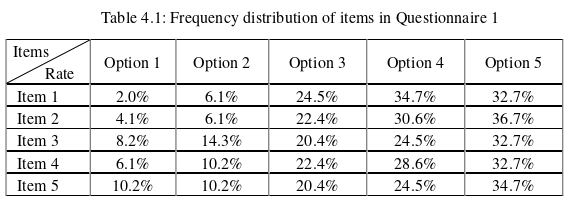本文是一篇英语论文,根据这项研究,我们可以知道语篇组织中的词块有利于英语书面语篇的教学。因此,从本研究的发现中可以得出一些教学启示。对于教师来说,他们应该教学生如何使用语篇组织中的词块来理解书面语篇。
Chapter One Introduction
1.1 Research Background
The National English Curriculum Standard for General Senior High School (2017) clearly states that the English discourse instruction should be based on discourse itself, and teachers should consciously introduce the basic knowledge of discourse reading to help students develop an awareness of discourse and grasp the characteristics of discourse structure, so as to enhance students’ English discourse comprehension competence. It can be seen that English instruction has paid attention to the cultivation of students’ English discourse comprehension competence in senior high schools. In recent years, although English discourse reading teaching has paid attention to developing English discourse reading competence of senior high school students, the effect of reading teaching is not satisfying. The reason is that English reading teaching in China has overemphasized the importance of teaching vocabulary and grammar rules in reading materials. Most of English teachers have placed a high value on teaching words and difficult sentences in reading materials, ignoring the teaching of discourse organization. Most of English teachers usually pay little attention to the logical connection between sentences and the coherence of reading discourse. At a result, English teachers only teach language points and grammar rules to students in the teaching of discourse reading, and students passively acquire vocabulary and grammar knowledge, which makes students unable to grasp the discourse structure and comprehend reading discourse quickly and effectively. Moreover, it also makes students fall into a bad habit of reading word by word to understand reading materials, which causes students to lose interest in reading. Therefore, it is of great significance to find a reasonable and effective approach to discourse reading teaching.
1.2 Purposes and Significance of the Study
Reading is an efficient way for learners to acquire information, so it plays an important role in English language learning. At present, English reading instruction is faced with higher requirements with the implementation of the National English Curriculum Standard for General Senior High School (2017). And, English reading teaching should have a good approach to improving the English reading competence of senior high students. According to Nattinger and DeCarrico’s theoretical research on lexical chunks, lexical chunks have the function of discourse organization. Lexical chunks of discourse organization can mark discourse structures and connect logically sentences and paragraphs. So, the recognition of lexical chunks of discourse organization in reading discourse is conducive to comprehending reading discourse. In view of this, this study attempted to testify the application of lexical chunks of discourse organization to English discourse reading teaching on students’ English discourse reading competence in a senior high school.
Up to now, scholars at home and abroad have mainly studied the influence of lexical chunks on vocabulary learning, writing learning and reading learning. However, there have been few empirical studies on the application of lexical chunks of discourse organization to English reading teaching. Therefore, this study applied lexical chunks of discourse organization to discourse reading instruction in order to improve senior high school students’ English reading comprehension competence.
Chapter Two Literature Review
2.1 Lexical Chunk Theory
2.1.1 Definition of Lexical Chunks
Lexical chunks have always been a hot topic in the field of the studies of the second language acquisition. However, up to now, there have been a lot of different definitions of lexical chunks. George A. Miller (1956) proposed the concept of “chunks” from the perspective of cognitive psychology. This laid the psychological foundation for the later scholars to introduce the concept of “chunks” into the field of linguistics. Since that time, many researchers have defined the concept of lexical chunks based on different research backgrounds, research perspectives, research purposes and research methods. Among them the most representative definitions were given by Becker (1975), Pawley and Syder (1983), Nattinger and DeCarrico (1992), Lewis (1993), Moon (1997), Wray (2002).
Becker (1975), a famous linguist, proposed the concept of “prefabricated chunks”, which suggests that language memory and storage, output and use are not based on a single word. He also pointed out that the lexical chunks with fixed or semi-fixed forms are the smallest units of human communication. Besides, he believed that lexical chunks are a particular “multi-word” vocabulary phenomenon, and he also believed that they are the combinations of function and form and have lexical and grammatical features. Pawley and Syder (1983) believed that lexical chunks are lexicalized sentence stems with fixed grammatical form and particular lexical content. And these fixed or semi-fixed chunks are accepted by language learners, who can use them to communicate more conveniently. Nattinger and DeCarrico (1992) pointed out that lexical chunks are multi-word units. They have their own grammatical rules and meanings, and each lexical chunk has its own pragmatic functions. Lewis (1993) believed that lexical chunks refer to two or more high-frequency words, phrases or sentence patterns which can be learned as a unit and are used by people in language communication. These high-frequency chunks have their own relatively fixed structures and relatively stable meanings. The learner can use them according to the specific situation. Moon (2002) held that chunks are “multi-word items”, which are combinations of words with semantic and syntactic meanings. Wray (2002) defined a lexical chunk as a combination of several words, which can be stored in the brain as a whole. They are prefabricated and can be extracted as a whole when in use, and do not need to be generated and analyzed through grammatical rules.
2.2 Related Studies on the Effects of Lexical Chunks on English Reading
The study of lexical chunks in the West has a longer history than that in China. Foreign scholars have achieved a lot of academic achievements in the study of lexical chunks. In our country, linguists have a relatively late start in the study of lexical chunks. In recent years, as a combination of function and form, the lexical chunk has attracted the attention of domestic scholars. This part presents an overview of the domestic and foreign research on the effects of lexical chunks on English reading.
2.2.1 Related Studies on the Effects of Lexical Chunks on English Reading Abroad
Foreign scholars’ research on the effects of lexical chunks on English reading can be divided into theoretical and empirical aspects. Widdowson (1979) was the first person to contribute to theoretical research. He believed that learners’ comprehension of discourse can be achieved by means of language interpretation skills and activation of background knowledge. That is to say, understanding of written discourse can be facilitated by some reading skills and strategies. Lexical chunks have this function, and they also play an important role in the understanding of discourse meanings. Nattinger and DeCarrico (1992) also proposed some suggestions for English teachers to teach reading. According to them, teachers should teach students how to recognize lexical chunks in order to help students understand written discourse better. They believed that some lexical chunks have a macroscopic function of discourse organization. In other words, the lexical chunks play an important role in marking the layout of written discourse, which is helpful for readers to grasp the macro structure of written discourse. Lewis (1997), the founder of lexical chunk theory, thought that lexical chunks can better help language learners grasp the context of discourse and gain the advantages of holistic learning.

Chapter Three Methodology ................................. 16
3.1 Research Questions ............................... 16
3.2 Research Subjects ..................................... 16
3.3 Research Instruments ..................................... 17
Chapter Four Results and Discussion ............................................ 26
4.1 Students’ Use of Lexical Chunks of Discourse Oganization in English Discourse Reading .................. 26
4.2 Effects of the Application of Lexical Chunks of Discourse Organization to English Discourse Reading Teaching on Students’ Reading Strategies ....... 29
Chapter Five Conclusion ........................ 41
5.1 Major Findings ................................. 41
5.2 Pedagogical Implications .................................. 42
Chapter Four Results and Discussion
4.1 Students’ Use of Lexical Chunks of Discourse Organization in English Discourse Reading
Questionnaire 1 was administered in the experimental class in order to explore senior high school students’ use of lexical chunks of discourse organization in English discourse reading. Before the teaching experiment, 49 questionnaires were distributed to the students, and the response rate was 100 percent.
The first figure shows the students’ knowing lexical chunks. The statistical results of the first item in the second part of Questionnaire 1 are as follows.

From Figure 4.1, we can see that 69 percent of all 49 students investigated did not know what lexical chunks were. 22 percent of the students knew lexical chunks a little and 5 percent of the students knew a lot about lexical chunks. Only 3 percent of them could understand the concept of lexical chunks and explain it with examples. Therefore, from this figure we can know that the overwhelming majority of the students failed to have a good understanding of lexical chunks. That is to say, most students did not have the awareness of lexical chunks.
Chapter Five Conclusion
5.1 Major Findings
This study attempted to explore the effects of lexical chunks of discourse organization on English written discourse comprehension of senior high school students. In order to answer the three research questions of this study, two questionnaires were administered in the experimental class and the pre-test and post-test were administered in the experimental class and the control class. According to the analysis of the research results, the major findings are stated as follows.
Firstly, according to the results of Questionnaire 1, it was discovered that the overwhelming majority of the students failed to have a clear idea of lexical chunks. That is to say, most of the students did not have the awareness of lexical chunks. Moreover, most students could not grasp the logical structure of written discourse and infer the meanings of written discourse with the help of lexical chunks of discourse organization. Besides, it was also found that most of the students tried to understand written discourse by reading it word by word and analyzing the grammatical rules. In addition, it was found that the students usually ignored discourse markers and they could not use the discourse markers to help them understand written discourse. In short, it was discovered that most senior high school students were lacking in the awareness of lexical chunks and did not know how to use lexical chunks of discourse organization to comprehend English discourse.
Secondly, after the teaching experiment, the students in the experimental class were asked to respond to Questionnaire 2. The results of the second questionnaire showed that the students’ reading strategies obviously changed after lexical chunks of discourse organization were applied to English discourse reading teaching. That is to say, the students in the experimental class mastered the reading strategies related to lexical chunks of discourse organization. To be specific, the students could use lexical chunks of discourse organization to understand the structure of written discourse and grasp the author’s intention and the main idea of the discourse. They paid much attention to lexical chunks of discourse organization in written discourse and could use these lexical chunks to grasp the logical structure of the discourse and infer the information of the discourse. In addition, the students could get the important information and the main idea of written discourse with the help of lexical chunks of discourse organization. It is evident that senior high school students’ reading strategies can be improved significantly after lexical chunks of discourse organization are applied to English discourse reading instruction.
reference(omitted)
